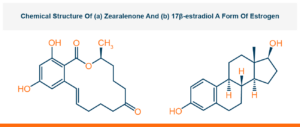Mycotoxins are a worldwide challenge for livestock producers. The presence of mycotoxins in feed materials represents a threat of disease and death in animals. Perhaps more of a problem is the subclinical losses to production, reproduction, and thus, efficiency that they can cause. Mycotoxins are formed as secondary metabolites by molds. Molds require nutrients and water to grow. Feedstuffs such as corn and silage can provide both, thus allowing for mycotoxin contamination to easily occur.
Recently Dairyland Laboratories, one of the leading agricultural testing labs in the US, released a report summarizing the amount of mycotoxin contamination they are finding in samples of the 2022 silage crop submitted by their customers. Only 2.5% of the tested samples were positive for aflatoxin. However, two of the six most important mycotoxins were found in more than 50% of the samples submitted.
The toxins coming in at over 50% were two mycotoxins produced by Fusarium molds: zearalenone and vomitoxin (aka DON, deoxynivalenol). Due to its chemical structure, zearalenone mimics estrogen (Figure 1) and once ingested and absorbed into the body, causes significant repercussions on all aspects of fertility in most livestock species. Zearalenone has also been shown to decrease immune responses, feed digestibility, and can result in inefficient animal production and reproduction. Vomitoxin is a mycotoxin that mainly affects swine. It depresses feed intake and gain, and in high enough concentrations, will cause pigs to vomit. Vomitoxin has also been used as a marker to indicate that the feedstuff may be contaminated with other mycotoxins.

Figure 1. Chemical structure of (a) zearalenone and (b) 17b-estradiol a form of estrogen
From the Dairyland Laboratories report, both zearalenone and vomitoxin increased in the 2022 corn silage crop. First, they increased in the percentage of samples that tested positive compared to the previous two years. Zearalenone was found in 88% of the current samples versus 76% in earlier years. Vomitoxin was in 92% of the new samples compared to 85% in the previous two years. Secondly, they increased in the median amount of mycotoxin that was present in the samples. The median number for zearalenone increased slightly from 0.079 ppm vs. 0.075 ppm in earlier samples. The same was true for vomitoxin, which increased from 1.1 ppm from October 2021 – September 2022 to 1.6 ppm in the new crop samples that were analyzed.
Table 1. Percent of submitted samples that tested positive for zearalenone, vomitoxin, or fumonisin.

Table adapted from Mycotoxin Trends – Corn Silage produced by Dairyland Laboratories, Inc. Arcadia, WI
Table 2. Concentration of zearalenone or vomitoxin present in submitted samples

Table adapted from Mycotoxin Trends – Corn Silage produced by Dairyland Laboratories, Inc. Arcadia, WI
Dairyland Laboratories did report an “uptick” in Fumonisin another Fusarium mycotoxin. Of the samples tested, 47% of the 2022 crop samples tested positive compared to 43% in the previous year. Of all species, horses and pigs have the worst reactions to dietary fumonisin. Horses can be affected at relatively low levels of fumonisin and develop leukoencephalomalacia, also called moldy corn syndrome or blind staggers. In this disease, there is damage to the horse’s brain. Fumonisin can also cause severe problems in pigs: pulmonary edema, and damage to the liver along with decreased growth performance. The other livestock species are thought to tolerate higher concentrations of fumonisin than horses or swine. However, numerous studies have shown that low levels of fumonisin or combinations of mycotoxins can have an impact on intestinal integrity.
Often a ration may be contaminated with more than one mycotoxin. This can be from one feed ingredient or several. This can result in additive or even synergistic negative effects, especially in non-research settings where other challenges such as heat stress, crowding, and disease pressure from viruses and bacteria are common.
Clostridium is ubiquitous bacteria. Increased concentrations of it in silage has been shown to decrease productivity. Research has shown that combinations of mycotoxins can exacerbate the effects of Clostridium on gut health. Low levels of fumonisin, for instance, make it easier for bacteria such as Clostridium and E. coli to attach to the gut, allowing them to proliferate. Clostridium bacteria, such as Clostridium perfringens release toxins that injure the intestine. This allows for a condition known as leaky gut; allowing unwanted substances into the body while decreasing the gut’s ability to absorb nutrients. Research has shown that combinations of mycotoxins can exacerbate the effects of Clostridium on gut health.
Mycotoxins in animal feed threatens their health. Measures must be taken by producers to manage and protect their livestock against mycotoxins to preserve the economic viability of their production. Sourcing effective technologies will be the key to moving producers to greater production, improved efficiencies, and increased profitability. At Amlan, we offer advanced feed additive solutions, including Calibrin®-Z (available in select international countries), that can mitigate mycotoxin challenges and optimize the intestinal environment to keep livestock healthy for improved performance. To learn more, click here.

